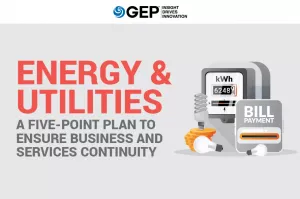On the whole, utilities are well-equipped to handle disruptions caused by disasters. The COVID-19 pandemic, however, is testing the most robust of emergency preparedness plans because of extended business lockdowns, transport restrictions and stay-home mandates.
The latest GEP bulletin, Energy & Utilities: A Five-Point Plan to Ensure Business and Services Continuity, evaluates key challenges that utility companies face and recommends actions for procurement teams to mitigate cash flow and supply risks, and ensure customers continue to get uninterrupted power and gas. It also discusses the urgent need to plan for concurrent disasters, as the hurricane season draws near.
What’s Inside:
- Leverage technology to avoid disruptions, improve safety
- Reach out to suppliers for mutual benefit
- The need to anticipate and prepare for parallel disasters
A must-read for procurement and supply chain professionals who want to reduce supply continuity risks and be prepared to handle other crises in the future.
Energy and utility companies have mature emergency preparedness plans, especially to handle natural disasters, but the current situation — an economic slowdown on the back of the coronavirus pandemic and an extended global shutdown — is unprecedented.
Utilities play a critical role in maintaining global stability. Among one of the essential services required for ensuring public health and safety, protecting critical infrastructure and national security, utility companies have to ensure that they can continue to provide uninterrupted service as the COVID-19 crisis deepens.
The coronavirus impact on the energy supply chain is as wide-reaching as on other industries, and companies must be prepared to handle continued supply chain and resource disruptions for a while. Here we look at some challenges and recommend preemptive actions:
CHALLENGE #1: STAFF EXPOSURE
Utility workers are critical for ensuring that the supply of gas and electricity remains uninterrupted to end customers and local communities. As these workers need access to residential, commercial and industrial buildings, they remain at a high risk of continued exposure to the virus. However, the utility industry is facing the same shortages of personal protective equipment as medical professionals — masks, gloves, sanitary disposables and disinfectants are all in short supply.
Recommendation: Leverage Teleworking and Digital Technology
A portion of the workforce can work remotely using technology for web meetings and collaboration on projects — procurement can source the required tools to facilitate teleworking. For personnel on the field, utilities can leverage technology to minimize the amount of manual work required. This will reduce both labor costs and the risk of employees getting exposed to the coronavirus. For example, basic geocoded photos can be used to document issues and verify completion of work, such as the replacement of a defective meter or pipe. More advanced technologies, such as drones coupled with LiDAR, can be used for remote sensing to inspect transmission lines, distribution poles and right of ways.
CHALLENGE #2: ONGOING MATERIALS SHORTAGE
The longer the global economy is shut down, the greater the risk that critical materials will become unavailable. Components such as generators, transformers, SCADA systems, meters and valves are at high risk due to high demand, existing shortages and long lead times, in a concentrated supplier market.
Recommendation: Find Alternative Sources of Supply and Improve Inventory Management
Utilities must review their critical inventory, especially highly engineered, long lead-time and single-sourced items. In the short term, consider sourcing materials from distributors who have a stockpile of this inventory. In some cases, the distributor may have a stronger relationship with the original equipment manufacturer because of the volumes purchased. Technology can also make a difference here. An AI-powered inventory management software can provide complete visibility into inventory, unify inventory management activities, monitor stock levels, generate replenishment orders and forecast demand.
CHALLENGE #3: IMPACT ON SUPPLIERS
- With the economic downturn, a significant number of companies have been downgraded, many have cut dividends. The oil and gas sector has been hit hard because of declining demand, low price of oil and high debts. As many oil and gas suppliers also sell products and services to utility clients, those suppliers may try to shift their business strategy to increase sales across the utility sector. Utility companies should be wary and do a thorough check on the financial health of these suppliers to determine if they are close to declaring bankruptcy, or looking to be acquired in order to survive.
- Most utilities have internal goals of purchasing from small or diverse business entities. The economic impact on these suppliers will probably be even harsher because of thinner margins, smaller cash reserves, and less access to capital.
Recommendation: Payment Terms and Supplier Outreach
- As the demand for most products and services declines, many suppliers will likely need cash to continue their operations. Renegotiating payment terms with early payment discounts can be mutually beneficial — it will help reduce your inventory risk and ease cash flow for suppliers. Utilities should identify their critical suppliers to help ensure that business is not disrupted.
- While the $2.2 trillion infrastructure stimulus package is expected to make $377 million available for small business loans, it might take time to reach your smaller suppliers. As a short-term strategy, utilities should consider reaching out to small and diverse suppliers and help retain their most productive and talented workers.
CHALLENGE #4: MAJOR SHIFTS OF QUALIFIED LABOR RESOURCES
Utilities may be at a high risk of losing their most productive contractors. The utility industry is highly dependent upon migratory construction labor. If the COVID-19 situation continues for much longer, the lockdown of regions and localized travel restrictions could affect the supply of qualified labor. Also, workers typically relocate during boom or bust cycles, to support major capital projects. With an impending recession, construction companies may put a significant number of projects on hold, or cancel them entirely. In addition, unemployment numbers are showing a rising trend — as per U.S. government data, 6.6 million people have filed for unemployment claims in the week ending March 28. These factors cumulatively suggest that workers will likely relocate across state lines — causing a greater shift of resources.
Recommendation: Partner with Your Contractors to Secure Labor
Utilities should partner with their critical contractors to help secure the contactors’ best teams. Companies may want to go so far as to set up a formal alliance or preferred partners program to help retain these key resources.
CHALLENGE #5: CONCURRENT DISASTERS
Utility companies have invested in emergency preparedness for years and are well-prepared on the whole. However, at this stage, they will be ill-equipped to handle a concurrent disaster — for example, hurricanes and storms or a cybersecurity breach — and may be forced to choose between which disaster to manage in order to maintain gas and power supplies.
Recommendation: Develop a Supply Chain Business Continuity Plan
Utilities should quickly re-evaluate their business continuity plan and anticipate other disruptions. Being proactive will yield significant benefits during an emergency. In particular, supply chain organizations should consider having a plan if technology goes down and if purchases need to be issued immediately. Having a strong plan that communicates roles and responsibility and levels of purchasing authority during emergency operations is critical.
RAPID RESPONSE SOLUTIONS FROM GEP
As the coronavirus crisis intensifies, managing your supply chain is going to get even more challenging. It may be worth finding a partner with deep experience in procurement and supply chain management to reinforce your capabilities and help you stay on course.
If you would like to have a conversation about how we can help, please reach out to our supply chain leadership.

Jason Allukian
Director, Consulting
GEP
Jason is responsible for managing large-scale strategic sourcing and supply chain projects in the energy and utility sectors at GEP. His areas of expertise include supply chain transformation, procurement, operations and maintenance strategy, negotiations, category management and supplier management. Prior to GEP, he has worked with a consulting firm, leading client-facing teams to develop and execute sourcing strategies of over $15 billion for Fortune 500 energy companies.

